Stargazing

|
The Zodiac Constellations |

|
- We now follow the line diagonally through the dipper to the star Castor. This
is part of the Zodiac constellation Gemini the twins. The two brightest stars
are Pollux, to the left, and Castor, to the right. {Trace out Gemini}.
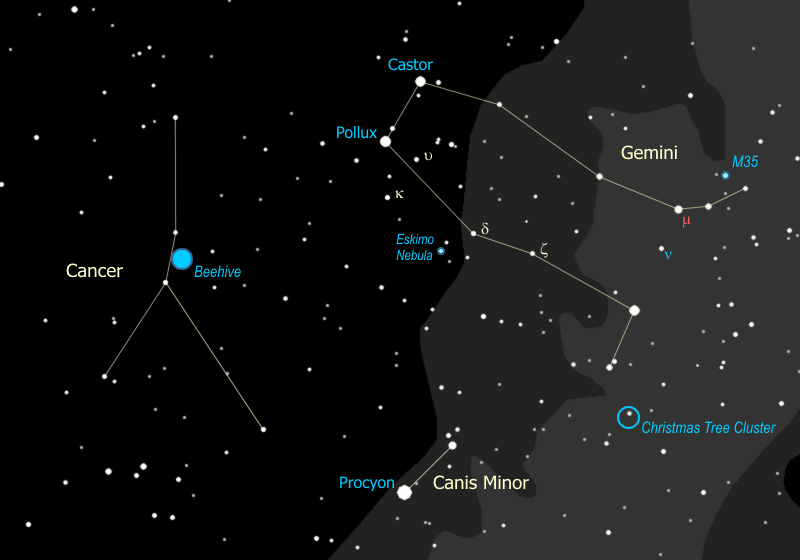
- That really bright star right next to Gemini is Procyon, the "Little Dog Star"
a mere 12 light years away, and belongs to the constellation Canis Minor, the
Little Dog, which is all of those two stars right there {Point out Canis Minor}.
The little dog belongs to Orion the great hunter, as does the Big Dog who we'll
talk about in a minute.
- The discovery of a planet orbiting Pollux in 2006 makes it one of the few
naked-eye stars known to have a planet. The planet
is at least twice the size of Jupiter and has an orbit about the same size
as Mars has around our sun. Even when Pollux was a younger star, at twice
the mass of our sun it was 10 times as bright, so even a small moon around
this planet would have been subjected to four times the intensity of radiation
that we are. Now, though, Pollux is entering the burn-out phases of a star
and has expanded, putting out 32 times the brilliance of our sun. So... not
likely there's anyone living there. We can't see the planet
in our telescope from 30-something light-years away, but we can see something
else...
- If we get Castor in the telescope at high magnification you can see it as a
double star. (Note to tourguide -- I don't usually attempt
this, I just mention it.) In reality, each of those stars is a double,
too close to see in our telescope, and then there is another, third star that
is also a part of the system which is ALSO a double. So while we can see two
stars (at best) in our telescope, Castor is actually a SIX STAR SYSTEM, about
50 light years away.
- Down by the foot of Castor (the twin), is the open cluster M35, a pretty darn
good cluster either in binoculars or in the telescope. If we have a clear,
dark night you may be able to spot it with your eyes alone. This cluster is
about 3,000 light years away and if you look carefully in a telescope, you can
see another cluster right next to it... that one is about 16,000 light years
or nearly six times as far away.
- Since they're twins Pollux gets to have a cool cluster down by his foot too.
If you look off the tip of the foot of Pollux you will see a line of three
stars pointing to the southwest, toward Orion's belt. Put the binoculars on
the first of those three stars (closest to Pollux's foot) and you will see
the Christmas tree cluster. The star you saw is the base of the tree, and
the rest of the tree is hanging upside down from the base. Photographs of
that region show a fascinating complex of gas clouds (nebulae) around those
stars.
M35 is easy to see in binoculars The Christmas Tree is upside down (North is up) 
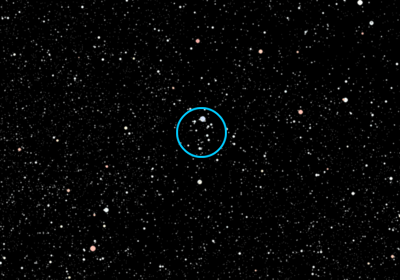
- As you go from Pollux' foot toward Pollux the star, you come across the
star ζ Geminorum. This is another
Cepheid variable with a cycle of
about 10 days. You can use the two bright stars near Pollux as your
gauge of ζ's brightness. The brighter one
to the south is κ (kappa) Geminorum, with a
magnitude of about 3.6, and the other one to the north (closer to Pollux)
is υ (upsilon) Geminorum, with a magnitude of
about 4.1. The variable ζ takes five days to
go from the brightness of υ to that of
κ, then another five days to go back again.
This is one of only three Cepheids you can see by eye - you already met
δ Cephei, the original, and the third one is
in the summer constellation of Aquila.
- If we continue on up the line from Pollux' foot toward Pollux the star,
you come across the star δ Geminorum. Next to
that star there is a small triangle of stars, {point out 56, 61, & 63
Geminorum} and that's where we are moving the telescope next. When you look
in the eyepiece you'll see a faint star and something else... a little fuzzy
spot. The little puff is known as the Eskimo Nebula, also called the Clown
Face Nebula. If we have a big enough telescope you can see the Clown's (or
Eskimo's) face, and with a really good telescope we can pick out a tiny
star at the center, making a clown's nose for us. Can anyone remember what
we call a little round nebula like this? That's right, this is another
planetary nebula, like the Blue Snowball we saw in Andromeda.
Eskimo in Telescope - can you see his face? What you're looking at (courtesy the Hubble Telescope) 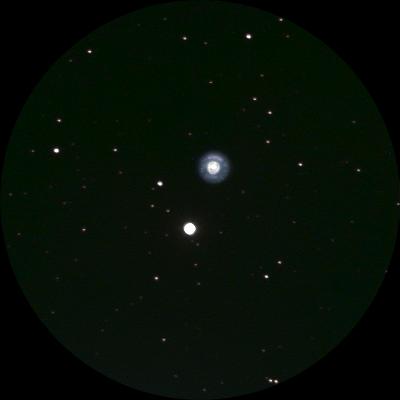

Look carefully and you may be able to see the tiny star that remains at the center of the Eskimo's face -- a once great star that is now a white dwarf.
- You can use Gemini to gauge how good your sky is... the clearer the
sky, the fainter the magnitudes you can see. Starting with 1st
magnitude Pollux and a very bright 2nd magnitude Castor, we
jump to the foot of Pollux (the twin) which is 2nd magnitude
and the foot of Castor which is made of two 3rd magnitude stars
and a 4th magnitude toe. Then the faint triangle next to
δ Geminorum, the one we used to find the Eskimo
Nebula, is made up of two 5th magnitude stars and a 6th
magnitude star, all of which can only be seen if you have a crystal clear,
perfectly dark sky. You can also use a line of 6th magnitude
stars that passes through Castor's foot (handy for helping to find M35 in
binoculars) as a test as well -- if you can see them without the binoculars
it's the best of skies.
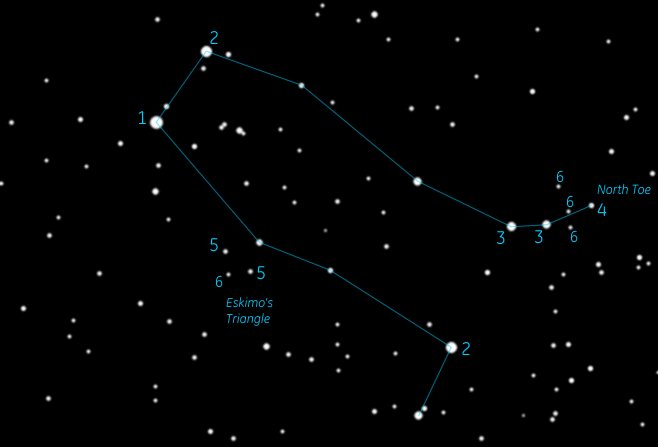
- I called Gemini a Zodiac constellation. What is a "Zodiac"
constellation? (I have been surprised to discover that
few, if any, kids can answer this question.)
As the earth goes around the sun, this motion means that every day we look back at the sun in a slightly different direction, with different stars behind it. The sun appears to move through the constellations. Theoretically there are twelve constellations through which the sun moves, one per month, and these are the Zodiac constellations. In reality there is a 13th constellation through which the sun passes (technically, at least) and it gets no credit for being in the Zodiac - Ophiuchus.

- So Gemini is one Zodiac constellation, and we've already talked about another
constellation on the path of the sun, can you guess which one? That's right,
Taurus is another Zodiac Constellation, on the sun's path just to the west of
Gemini, so the sun passes through Taurus, then Gemini, then it continues on
through the next month's constellation, the ever so faint Crab with the
unfortunate name of "Cancer". {Trace out Cancer the Crab}
My real target here is the Beehive, and in some cases I don't
bother with Cancer at all -- I simply tell the group to look halfway between
the bright stars of Leo and the bright stars of Gemini -- in the center of the
dark region is a faint fuzzy spot. Most people will see it right away.
- It's so unremarkable I wouldn't even bother showing you this constellation,
except for one thing... the Beehive. If you look very carefully at
the center of the crab, you will see a hazy patch. Now look at that hazy patch
through the binoculars. Wow, eh? That's the Beehive Cluster, about 500 light
years away. It is about the same distance as the Pleiades (not nearly as bright,
is it?) and the same age as the Hyades, 400 million years old, and some people
think the Beehive & Hyades are related because they're both moving at the same
speed in the same direction. The fact that they are about 450 light years apart
is hard to explain though.
The Beehive is so big you can see it just by looking 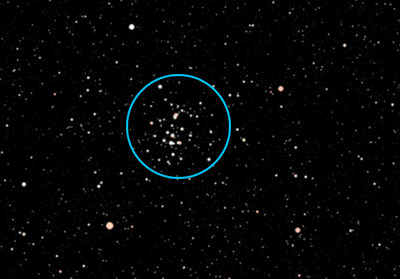
- If you're going for the Astronomy merit badge you need four
Zodiac constellations and it just so happens you're in luck... we've got one
more, this time going west from Taurus. So this is on the sun's path
before it reaches Taurus; just to the west of the Pleiades you find
the constellation Aries the Ram. The easiest part of the constellation
to spot is a set of three bright stars forming a bent line or a very flat
triangle. {Point out the central stars in Aries.} Most star charts only
show these three stars. However, if you follow the line of the whole
constellation you get a much better sense of the ram's horns. {Trace out the
full constellation.}

- The little bitty triangle buzzing around to the left of the bright central
stars of Aries used to be a constellation of its own, called the Northern
Fly. {Point out the Northern Fly.} Mercifully the fly was gassed and now
those stars are officially part of Aries. (There is a Southern Fly - since
the demise of Northern Fly the Southern Fly is just the Fly - near the
Southern Cross close to the South Pole. We can't see it.)
- Just to the north of Aries you might notice a distinct, narrow triangle of stars,
which happens to be another constellation whose name is, surprisingly enough,
Triangulum. {Trace out Triangulum}
- Aside from being a neat looking constellation, Triangulum is the home of another
galaxy, M33. This galaxy is just a little farther from us than the Andromeda
galaxy, about 2.4 million light years away, and belongs to our group of galaxies
- astronomers refer to this as the "Local Group".
M33 has a reputation for being tough to see and we need a clear, dark sky to really be able to see it. {Point out M33's location} It is so big, faint, and spread out, that it is actually easier to see in binoculars (if we can see it at all) than in a telescope. On a very dark night you might even be able to see it with your eyes alone, by looking just to one side of it (averted vision).
- The three bright stars of Aries are α (alpha),
β (beta), and γ (gamma).
If we get the telescope on γ, you can see that it is
also a binary, a close pair of clear white stars. If you don't want to bother
with the telescope you can spot another double with the binoculars -- mid-way
and slightly above the line between γ and
β is λ Arietis, a bright yellow
star with a faint yellow companion, just above it. You can spot the faint twin
with 10x50 binoculars - if you hold them rock steady. Both of these double
stars, γ and λ, are true
binary systems -- twin stars that were formed together and are now orbiting one
another.
 |
 |
 |
| Back to The Bears | Go to Winter Index | On to Canis Major |
Questions
Your questions and comments regarding the Stargazing section are welcome.
You can e-mail the author, Randy Culp for inquiries,
suggestions, new ideas or just to chat.
Updated 18 July 2023
